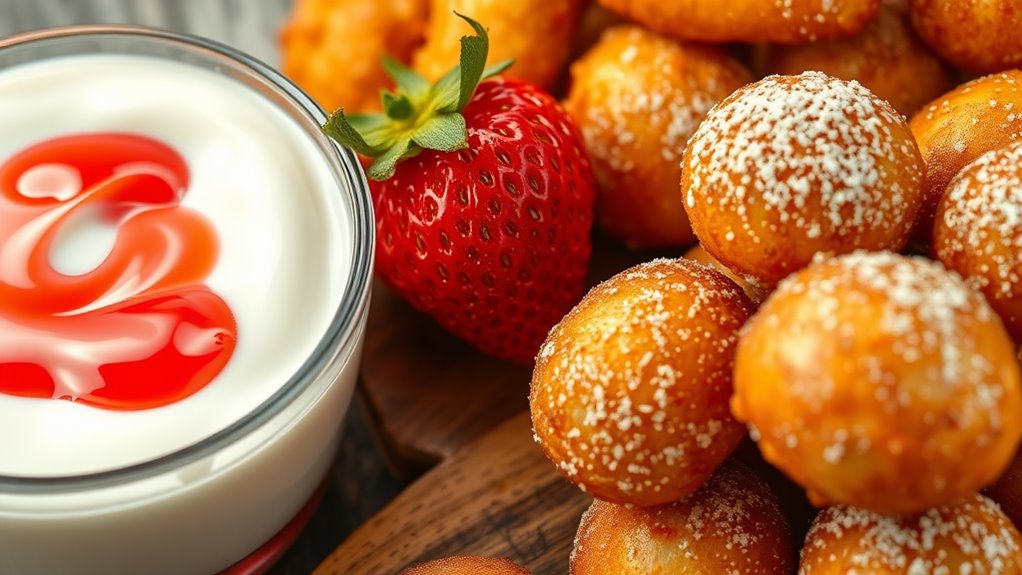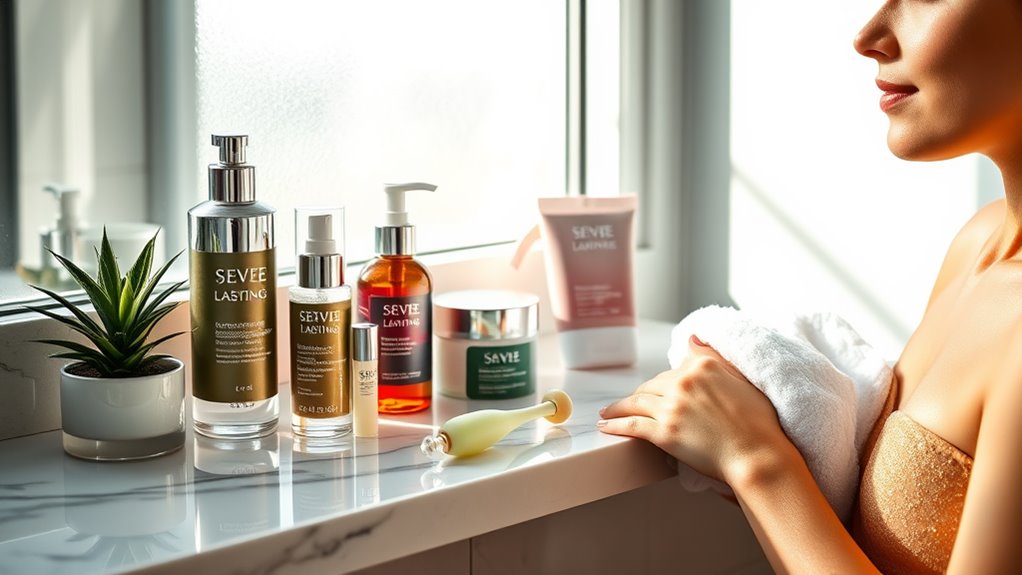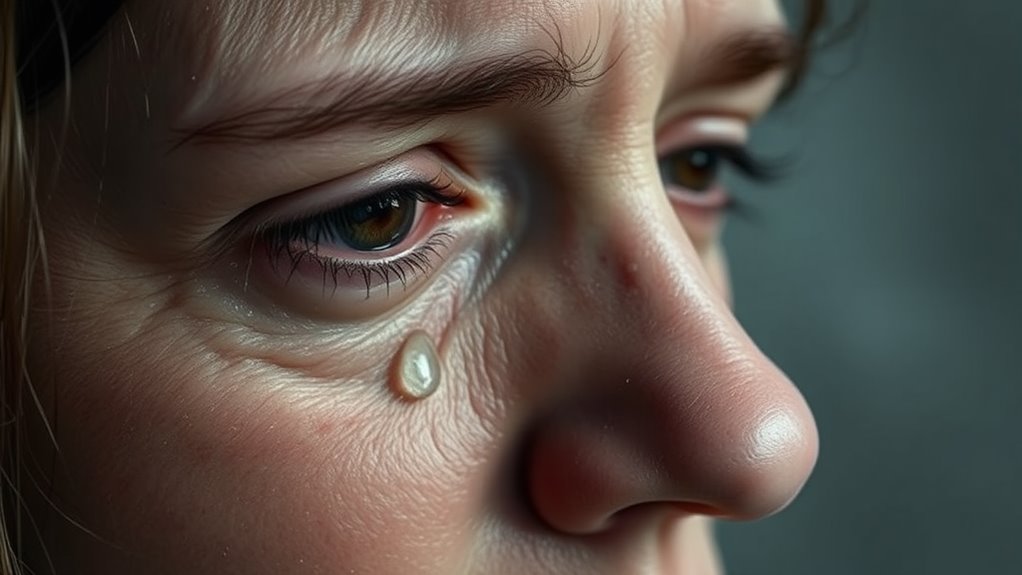These Foods Could Be the Reason for Your Breakouts
Dairy products, sugary snacks, and refined carbohydrates can all trigger breakouts by increasing oil production and inflammation. Fast food and greasy foods contribute unhealthy fats that clog pores, while processed meats and preservatives also disrupt your skin’s balance. Additionally, spicy foods, alcohol, caffeine, and artificial sweeteners can exacerbate skin issues. To improve your skin health, it’s essential to be mindful of these foods in your diet. Stick around to find out more about how to achieve clearer skin.
Key Takeaways
- Dairy products, especially skim milk, may increase acne prevalence due to hormones stimulating oil production and causing inflammation.
- Sugary snacks and high glycemic index foods trigger insulin spikes, leading to increased oil production and acne development.
- Refined carbohydrates like white bread and pastries cause blood sugar surges, which can clog pores and worsen acne.
- Fast food and greasy foods are high in unhealthy fats and refined carbs, exacerbating oil production and inflammation in the skin.
- Processed meats contain preservatives and saturated fats that can disrupt skin balance and contribute to breakouts.
Dairy Products
When you enjoy dairy products, you mightn’t realize they could be contributing to breakouts. Research indicates that dairy, particularly skim milk, is linked to increased acne prevalence.
This connection may stem from hormones present in milk, which can stimulate oil production and exacerbate acne. Additionally, the insulin response triggered by dairy consumption can lead to inflammation, another factor in skin issues. Consuming dairy products may also increase the likelihood of developing cystic acne, which is often more severe and difficult to treat.
While not everyone experiences acne from dairy, it’s essential to monitor your skin’s response after consuming these foods. If you suspect dairy’s playing a role in your breakouts, consider reducing your intake and observe any changes.
Sugary Snacks
Sugary snacks can trigger insulin spikes that may lead to increased oil production in your skin. This excess oil, combined with inflammation, can create an environment that’s ripe for acne breakouts. Additionally, high sugar intake has been linked to various skin issues, further exacerbating the problem.
Insulin Spike Effects
While indulging in sugary snacks might seem harmless, the insulin spikes they trigger can have significant repercussions for your skin.
Elevated insulin levels lead to an increase in sebum production and skin cell turnover, creating a perfect storm for breakouts. Here’s what you need to know:
-
Increased oil production: Your body produces more oil, which can clog pores.
-
Higher androgen levels: Insulin can boost androgen hormones, triggering acne.
-
Impaired healing: Elevated insulin may slow down your skin’s natural healing process.
Inflammation and Acne Connection
High insulin levels from sugary snacks not only increase oil production but also trigger inflammation, which plays a significant role in acne development. When you indulge in these treats, your body reacts by producing more sebum and inflammatory markers, leading to clogged pores and breakouts.
| Sugary Snacks | Impact on Acne |
|---|---|
| Candy | High sugar content spikes insulin, increasing oil production. |
| Soda | Phosphoric acid may worsen inflammation and acne. |
| Cookies & Cakes | Refined carbs can elevate blood sugar levels, worsening skin. |
| Ice Cream | Dairy and sugars contribute to hormonal fluctuations. |
Refined Carbohydrates
Refined carbohydrates, like white bread and pasta, can lead to significant blood sugar spikes in your body. These spikes trigger inflammation, which has been linked to increased acne production. Additionally, inflammation is a key factor in the development of acne, making it essential to monitor your intake of these foods.
Blood Sugar Spikes
Many people don’t realize that foods high in refined carbohydrates can lead to blood sugar spikes, which may contribute to breakouts. When your blood sugar levels surge, your body produces more insulin, potentially leading to increased oil production and clogged pores.
To keep your skin clear, consider minimizing your intake of:
- White bread and pastries
- Sugary cereals and snacks
- Pasta made from white flour
These foods can cause rapid fluctuations in blood glucose levels, which might exacerbate acne.
Instead, focus on whole grains and balanced meals to stabilize your blood sugar. By doing so, you not only support your skin health but also promote overall well-being.
Understanding this connection is a crucial step toward mastering your diet for clearer skin.
Inflammation and Acne
When you consume refined carbohydrates, your body can experience an inflammatory response that may worsen acne. These foods, such as white bread, pastries, and sugary snacks, rapidly increase your blood sugar levels.
In turn, this spike triggers insulin production, which can lead to increased oil production in your skin. The excess oil, combined with inflammation, creates an ideal environment for acne-causing bacteria to thrive.
Research shows a strong link between high-glycemic diets and acne severity, emphasizing the importance of choosing whole grains and low-glycemic options. By reducing refined carbohydrates in your diet, you can help manage inflammation and potentially improve your skin’s condition.
Prioritizing nutrient-dense foods can lead to clearer, healthier skin over time.
Fast Food
While you might crave a quick meal from your favorite fast-food joint, indulging too often can lead to unwanted breakouts. Fast food is typically loaded with refined carbohydrates, unhealthy fats, and high sugar content, all of which can trigger inflammation and hormonal fluctuations in your skin.
Consider these factors:
-
High Glycemic Index: Fast food is often high in sugars and simple carbs, causing spikes in insulin that can exacerbate acne.
-
Unhealthy Fats: The trans fats found in fried foods can lead to increased oil production, clogging pores.
-
Lack of Nutrients: Fast food lacks essential vitamins and minerals that promote healthy skin, leading to a dull complexion.
Additionally, dietary choices can significantly impact your skin health, making it crucial to be mindful of what you consume.
Chocolate
Although chocolate is often considered a delightful treat, it can also contribute to breakouts for some individuals.
Research suggests that chocolate, particularly milk chocolate, contains dairy and sugar, both of which can trigger acne flare-ups. Dairy products, rich in hormones, may stimulate oil production in your skin.
Meanwhile, the high sugar content can lead to insulin spikes, promoting inflammation and oiliness. If you’re prone to breakouts, you might want to monitor your chocolate intake.
Opting for dark chocolate could be a better choice, as it typically contains less sugar and more antioxidants. Additionally, avoiding habits that worsen acne can further help in maintaining clearer skin.
Ultimately, understanding how chocolate affects your skin can help you make informed dietary choices and potentially reduce breakouts.
Greasy Foods
Greasy foods, including those high in fat and oil-fried dishes, can contribute to breakouts by increasing oil production in your skin.
Additionally, dairy products often contain hormones that may exacerbate acne.
High-Fat Ingredients
When you indulge in high-fat ingredients, like those found in many greasy foods, your skin might pay the price. These fats can lead to increased oil production, which clogs pores and triggers breakouts.
Here are some high-fat ingredients to be mindful of:
-
Saturated fats: Often found in red meat and full-fat dairy, these can influence inflammation and skin health.
-
Trans fats: Common in processed snacks and fried foods, these unhealthy fats may aggravate acne.
-
Omega-6 fatty acids: While essential, an excess from sources like vegetable oils can lead to imbalances that provoke skin issues.
Being aware of these high-fat ingredients can help you make better dietary choices and maintain clearer skin.
Oil-Fried Dishes
Oil-fried dishes are notorious for their impact on skin health, particularly when it comes to breakouts. These greasy foods can increase oil production and clog your pores, leading to acne. When you indulge in deep-fried items, the excess oil can trigger inflammation and exacerbate existing skin problems.
| Food Type | Acne Potential |
|---|---|
| French Fries | High |
| Fried Chicken | Moderate |
| Tempura Vegetables | Low |
To maintain clear skin, consider limiting your intake of these oil-laden options. Opting for baked or grilled alternatives not only supports your skin but also promotes overall health. Remember, what you eat significantly influences your complexion.
Dairy Products Impact
While you might enjoy a slice of pizza or a creamy latte, dairy products can significantly affect your skin’s health and contribute to breakouts.
Research indicates that dairy may elevate insulin levels, leading to increased oil production and clogged pores. If you’re serious about achieving clear skin, consider these factors:
-
Hormones in Dairy: Milk contains hormones that can trigger acne flare-ups.
-
High Glycemic Index: Dairy products can lead to spikes in blood sugar, exacerbating inflammation.
-
Inflammatory Response: Some individuals may have an inflammatory reaction to dairy, resulting in skin issues.
Processed Meats
Processed meats can easily sneak into your diet, but they might be contributing to your skin issues. These products often contain preservatives and high levels of sodium, which can lead to inflammation and breakouts. Additionally, the saturated fats and chemicals in processed meats may disrupt your skin’s natural balance.
Here’s a quick overview of common processed meats and their potential effects:
| Processed Meat | Common Ingredients | Possible Skin Impact |
|---|---|---|
| Bacon | Nitrites, sodium | Inflammation, acne |
| Sausages | Preservatives, fats | Clogged pores, irritation |
| Deli Meats | Salt, artificial flavors | Breakouts, redness |
| Hot Dogs | Fillers, additives | Skin irritation, puffiness |
Consider reducing these meats for clearer skin.
High Glycemic Index Foods
Many people don’t realize that high glycemic index (GI) foods can significantly impact your skin health. When you consume these foods, your body experiences rapid spikes in blood sugar, leading to increased insulin production. This can result in inflammation and breakouts.
Consider reducing your intake of:
- White bread and pastries
- Sugary cereals and snacks
- Soft drinks and energy drinks
Opt for low GI alternatives like whole grains, legumes, and vegetables. These options promote stable blood sugar levels and may help maintain clearer skin.
Spicy Foods
Spicy foods can have a surprising effect on your skin, particularly if you’re prone to breakouts. The capsaicin in chili peppers can stimulate blood circulation and increase oil production in your skin, which may lead to clogged pores.
Additionally, spicy foods can trigger inflammation, exacerbating existing acne. If you notice frequent flare-ups after indulging in spicy dishes, it might be time to reconsider your diet.
While not everyone will experience breakouts from spicy foods, those with sensitive skin or underlying conditions may be more susceptible. To maintain clear skin, monitor your intake of spicy ingredients and observe any changes in your complexion.
Keeping a food diary can help you pinpoint specific triggers for your breakouts.
Alcohol
Although you might enjoy a drink to unwind, alcohol can negatively impact your skin, particularly if you’re prone to breakouts. Here’s how alcohol affects your complexion:
-
Dehydration: Alcohol dehydrates your skin, leading to increased oil production, which can clog pores.
-
Inflammation: It triggers inflammatory responses, potentially worsening existing acne and contributing to new breakouts.
-
Hormonal Imbalance: Alcohol can disrupt hormonal levels, which may lead to an increase in acne flare-ups.
Being mindful of your alcohol intake is crucial for maintaining clear skin.
If you notice a pattern of breakouts following drinking, consider reducing your consumption.
Prioritize hydration and a balanced diet to support your skin’s health and reduce the likelihood of breakouts.
Caffeine
While you might rely on caffeine to boost your energy, it can also contribute to skin issues, particularly if you’re prone to breakouts. Caffeine stimulates the adrenal glands, leading to increased cortisol production. Elevated cortisol levels can trigger oil production, clogging pores and promoting acne.
Furthermore, excessive caffeine consumption can dehydrate your skin, making it more susceptible to irritation and inflammation. If you’re consuming caffeine in the form of sugary drinks, those added sugars may exacerbate your skin problems, too.
To manage breakouts effectively, consider reducing your caffeine intake or switching to lower-caffeine options like green tea. Staying hydrated and maintaining a balanced diet can also support your skin’s health while minimizing the potential negative effects of caffeine.
Artificial Sweeteners
If you’re trying to reduce sugar intake, you might turn to artificial sweeteners as an alternative.
However, these substitutes can have unintended effects on your skin. Research suggests that certain sweeteners may trigger hormonal imbalances, leading to increased oil production and breakouts.
Consider the following potential issues:
-
Insulin Response: Some artificial sweeteners can cause insulin spikes, which may contribute to acne.
-
Gut Health: They can disrupt gut microbiota, potentially leading to inflammatory skin conditions.
-
Addictive Nature: Their sweetness can lead to cravings for more sugar, perpetuating unhealthy eating habits.
Be mindful of your choices; what seems like a healthier option could be the culprit behind your breakouts.
Prioritize whole foods to maintain clear skin.




